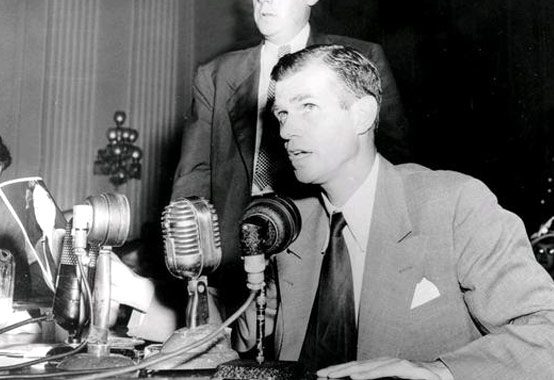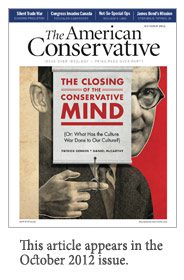The Spirit of Treason

In his piercing Harvard Commencement Address of 1978, Aleksandr Solzhenitsyn, the former prisoner of the Soviet Gulag who found freedom and truth within its strictures, offered a “measure of bitter truth” to his American audience. Solzhenitsyn referred to an “anthropocentric humanism” that had enveloped the West in the modern period and shaped the understanding many Americans had of science, technology, government, and what it means to be a human being. Such a “rationalistic humanism” can be seen, Solzhenitsyn announced, in the “practiced autonomy of man from any higher force above him.”
Solzhenitsyn strikingly proclaimed that the West had actually joined with its Communist foes in affirming a rationalistic and materialistic humanism, leaving the West incapable of understanding the true enemy. Both East and West saw man “as the center of all.” The West’s late-modern humanism was cut off from its Christian heritage, Solzhenitsyn argued, and had no principled objection to the more extreme forms of materialism and rationalism that promised the human will the ability to construct a perfected political, social, and technological existence. Thus liberalism loses to radicalism, radicalism becomes socialism, and socialism gives way to communism. Solzhenitsyn’s powerfully stated argument about the trajectory of modern rationalism supplies much of the answer Christina Shelton is reaching for in Alger Hiss: Why He Chose Treason.
Shelton’s book probes a question many observers of Alger Hiss have long wondered about: why did Hiss doggedly maintain his innocence of charges that he was a spy for the Soviet Union, not only after he was accused by Whittaker Chambers in 1948, but after his federal conviction in 1950, even until his death in 1996? Shelton’s verdict on Hiss’s refusal to recant or apologize is that he believed as a matter of conscience in the rational constructive project of communism. For Hiss, the vindication of man rested in communist soulcraft.
There is no new factual information in Shelton’s book, or none that I could detect. Quite simply, the ground has been trod, plowed, and sifted by so many that a book on Hiss must, of necessity, investigate the existential questions surrounding his life and character if it is to have value. Shelton retells Hiss’s coming to Washington in 1933 as a concealed radical lawyer in the New Deal. He first worked for the Agricultural Adjustment Administration, later transferring to the Justice Department and then to State, where he occupied several different high-level positions. Hiss joined the Ware Group at some point in late 1933 while working at the AAA. The Ware Group consisted of prominent civil servants in New Deal agencies and was ultimately controlled by the GRU, Soviet military intelligence. Although initially something of a communist study group, Ware’s members were willing, as part of their commitment to Soviet communism, to engage in espionage on its behalf.
Whittaker Chambers assumed control of the Ware Group in 1934, his first covert assignment as a Soviet agent. Here began the ideological and personal friendship between Hiss and Chambers that would shatter when Chambers left communism and the Soviet underground in 1938. Most of what Hiss clandestinely provided to Chambers were copies—typed by Hiss’s wife, Priscilla, on their infamous Woodstock typewriter—of documents and materials he procured from the State Department. Chambers then transferred these documents to other Soviet agents. Shelton provides these facts not to re-establish Hiss’s guilt but to frame the depth of his belief and his willingness to aid the Soviet Union.
While Shelton’s book is a philosophical and psychological investigation of Hiss, with sociological observations about progressive elites tossed in for good measure; her work stands on the shoulders of historical giants. Allen Weinstein’s Perjury and The Haunted Wood, the latter coauthored with Alexander Vassiliev, are of great significance. The latest historical addition to understanding Soviet espionage in America and one that provides further, painstaking confirmation of Hiss’s guilt, came in 2009 with John Earl Haynes, Harvey Klehr, and Alexander Vassiliev’s Spies: The Rise and Fall of the KGB in America. Based on information compiled by the ex-KGB agent Vassiliev during his three years of work in the KGB archives after the fall of the Soviet Union, the authors make these concluding remarks on Hiss’s guilt:
[Hiss] was identified in Soviet intelligence documents by his real name and three different cover names, each of which is clearly and demonstrably linked to him. KGB officers and CPUSA underground leaders knew him as a member of the Soviet apparatus. Several of his fellow agents … identified him as an agent in confidential communications that made their way back to Moscow. And its own damage assessments confirm that Soviet intelligence knew that Alger Hiss belonged to it. Case closed.
Shelton builds on this consensus and explores “Hiss in the strategic context of American political philosophy and Communist ideology.” Hiss, Shelton observes, has been a symbol in the “philosophical political struggle within the United States for more than two centuries … between individuals … who believed in statism … and those who advocate individual liberty and limited, decentralized government.” She underscores the informative light cast on Hiss’s communist allegiance by his morally muted reactions to the Bolshevik Revolution, the Nazi-Soviet Pact of 1939, Stalin’s purges, and Chairman Mao’s inducement of famine, not to mention Hiss’s reaction to Chambers’s defection. Hiss doubted that millions had died in Mao’s engineered famines because “the problem of liquidation which Mao would have undertaken must have been minimized” given the vast numbers of supporters of Chiang Kai-Shek who fled the country or died in the internal war. Of this, Shelton asks, “Was Hiss really suggesting that Mao killed fewer people because there were less available to kill?”
Perhaps sensing that something more must be said about Hiss’s contribution to America’s foreign policy, Shelton focuses a chapter on Hiss’s role at the 1945 Yalta Conference. The arguments made here at times take us beyond the facts. This is not to say that what Shelton alleges is wrong, but that the evidence, at this moment, does not fully corroborate her analysis.
GRU, not the KGB, ran clandestine operations in the United States until late in the 1940s. The GRU’s influence ended with the titanic defections of Igor Gouzenko and Elizabeth Bentley in 1945, which compromised GRU’s underground networks in Canada and America. Incidentally, both Gouzenko and Bentley included Hiss among dozens of other names they provided to the federal government.
While KGB archives have been made at least partially available to researchers, the GRU archives have not been subject to similar review. Thus, Shelton’s claim that Hiss at the 1945 Yalta Conference met with Soviet general Mikhail Milshtein, a deputy chief of the GRU’s first directorate during Yalta, and who was probably Hiss’s handler at one point in the late 1930s, is informed speculation. So too is a related contention that Hiss was likely holding papers beyond his pay grade at Yalta—on America’s position concerning the postwar status of Poland, managing the internal Chinese conflict vis-a-vis Japan, Nazi reparations, and other issues—and that he likely passed these materials to Milshtein. Shelton admits that these claims have never been corroborated by “documentary evidence.”
A far-too-short chapter on Whittaker Chambers presents the details of his underground connection and friendship with Hiss but omits Chambers’s more searing and introspective analyses of Hiss and of communist ideology. Shelton relies on Chambers’s striking discernment of why progressive New Dealers were unable to see traitorous communists in their midst: he argued that progressives’ ideals were largely fulfilled by communists and the former differed from the latter merely in the interpretation and implementation of those ideals within a democracy. The venom progressives directed at Chambers for charging their colleagues with betrayal resulted, in part, from the inability of these same well-heeled liberals to believe that people who shared their social and educational backgrounds and broad left-wing humanitarian views could be committed communists and Soviet spies.
Chambers’s deeper point, which anticipates Solzhenitsyn’s argument, is that progressives find it difficult to differentiate themselves from communists because both groups have a similar understanding of human action. Progressives and communists believe in man operating with an unbounded and liberating reason, if only he can break free of the historical shackles that have constrained him thus far. This is the basis for the oft-heard line “No enemies to the left.”
 Shelton, unfortunately, misses the opportunity to contrast Chambers and Hiss in the full extent of their commitments. To have made this contrast would have greatly illuminated why Hiss remained an inveterate defender of his innocence. This point was never lost on Whittaker Chambers. He stated that the connection both men shared, even in opposition, was the force of their existential allegiances, which, Chambers observed, a bourgeois America could not grasp. Paradoxically, Chambers’ exit from communism provides the deepest source for understanding why Alger Hiss chose treason. Chambers described his own conversion by evoking language from Henri de Lubac’s The Drama of Atheistic Humanism, a work he adored:
Shelton, unfortunately, misses the opportunity to contrast Chambers and Hiss in the full extent of their commitments. To have made this contrast would have greatly illuminated why Hiss remained an inveterate defender of his innocence. This point was never lost on Whittaker Chambers. He stated that the connection both men shared, even in opposition, was the force of their existential allegiances, which, Chambers observed, a bourgeois America could not grasp. Paradoxically, Chambers’ exit from communism provides the deepest source for understanding why Alger Hiss chose treason. Chambers described his own conversion by evoking language from Henri de Lubac’s The Drama of Atheistic Humanism, a work he adored:
What I had been fell from me like dirty rags. The rags that fell from me were not only Communism. What fell was the whole web of the materialist modern mind—the luminous shroud which it has spun about the spirit of man, paralyzing in the name of rationalism the instinct of his soul for God, denying in the name of knowledge the reality of the soul and its birthright in that mystery on which mere knowledge falters and shatters at every step.
Chambers’s conversion was to a world of man under God and of understanding that man’s vocation was to live and suffer with his freedom and dignity upon a stage that man did not create. To choose communism was to engage in metaphysical revolt. Hiss refused such humility and wedded his spirit to bringing a new liberated world into existence at the cost of friendships, honesty, mercy, even loyalty to one’s country. Chambers’s self-immolation in testifying against Hiss, and Hiss’s refusal to admit guilt, is best understood in this unforgiving spiritual light.
Richard M. Reinsch II is a fellow at Liberty Fund and is the author of Whittaker Chambers: The Spirit of a Counterrevolutionary.